The Beach Thing
I believe that the term was first coined by Tyler, to the indignation of Rodolfo, who insisted it was a highly sophisticated "ethnography project" not some run of the mill "beach thing." Since we knew nothing more than the fact that it would be at the beach, until the day before we left, however, the name stuck.
On Friday we did receive a run through of the goals and schedule of "La Poderosa Media Project" that we would be embarking on the next day-enough info to pack and get ready to depart. Pilar was our guide/professor for the week, and she was also the one who came to the last hour of Rodolfo's class to enlighten us about our adventures to come. A native of Quito, she did her undergraduate at Welsley College, and recently finished her PhD in Anthropology at the University of Illinois in Champagne Urbana. Her specialty is food traditions, and she has done work in Cuba and previously in Bahía with this-we were clearly in capable hands.
As you likely already read, we arrived without difficulty in Bahía de Caraquéz on Saturday evening, and Sunday was occupied with a trip to the San Vicente and Bahía mercados, as well as some informal but informative class about participant observation, that pretty much made me consider being an anthropologist….That beach that was calling to me at the end of the last post looked like this:
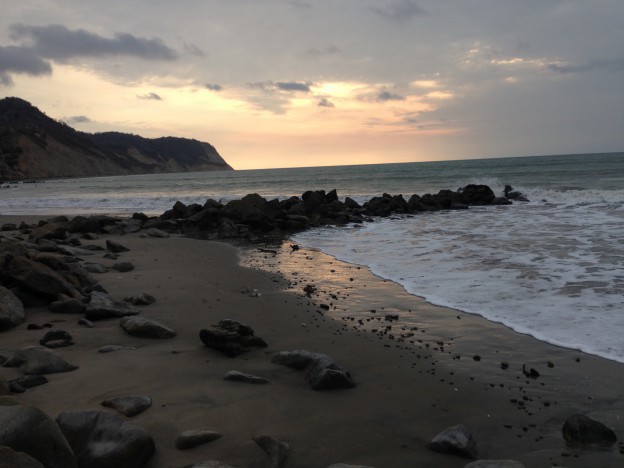
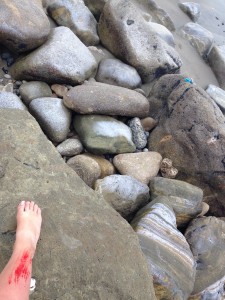
Monday morning we had some breakfast on our lovely terrace, then set off for "La Finca De La Esperanza" owned by Marcos and his wife Rosilla (from Syracuse NY-small world, anyone?) After a taxi ride, we switched to pickups, then continued to walk out to the startup farm that the couple had bought. They built all the structures that are currently there from nothing, either finding there or carrying all the materials needed on the same hour long hike we had taken through the forest to arrive there. We got to try some cocoa pulp (is that what you would call it?) and they walked us through the process of turning what we were nibbling on into hot coco (ok, technically we were nibbling the pulp, and the seeds are what chocolate is made of, but you get the idea). First you plant this tree, waiting four years for it to bear fruit, if I am remembering correctly, then, once you see a pod about like this:
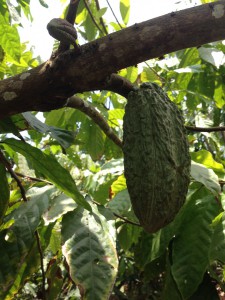
You pick it, and let it dry a few days
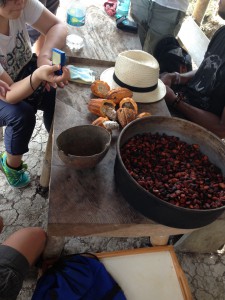
Then the beans are removed from the shell of the fruit, and fermented
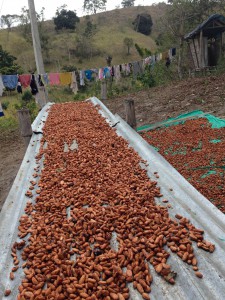
then comes the roasting, which Marcos did over a wood stove made from half a recycled oil drum, apparently a typical oven for the area (the roasted beans are in the picture before.) Then comes the discarding of the now burned and crispy pulp that is leftover even after the fermentation and drying. We all pitched in for this-ending up with sooty hands all around. We washed our black palms as Marcos began the grinding process with his fancy machine that was carried out there in pieces on horseback.

After more than 5 runs through the machine, the paste was mixed with milk and cooked.
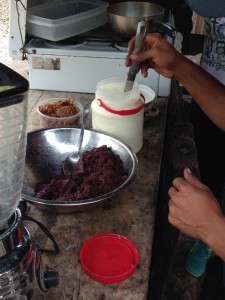
Part of the paste was mixed with just enough liquid to form a rich thick sauce, and the rest for chocolate milk.

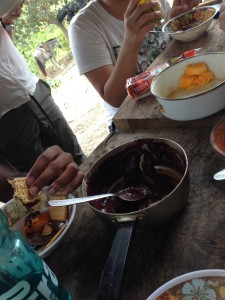
We finished up the day with a tour of their garden (they feed themselves and their two young daughters almost totally on what they grow or collect from their land) and finally arrived, hungry, hot exhausted and thirsty to Marcos's parent's house. There, we devoured a delicious lunch of soup, rice, and salad. Minori, Tyler, Sarah and I enjoyed the ride back to Bahía in the back of the pickup probably more than was totally reasonable. We all agreed we were much too exhausted for the planned lesson that day (especially since we returned many hours later than expected) and planned to have extra class the next day. That night we noticed this on our way out to dinner:
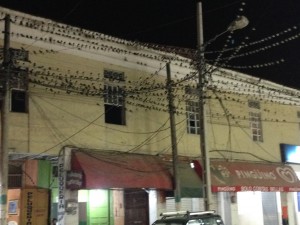
Tuesday took us to the cultural museum in the city, where our other guide/friends work, Javier and Sixtina, who, after a tour of some of the artifacts of the local pre-colombian cultures, explained the other work that the museum does. They seem to do a rather astonishing job engaging the community through hosting musical and artistic events open for children and teens in the community especially, to involving these same locals in mural projects around the province, some of which we got to go and visit
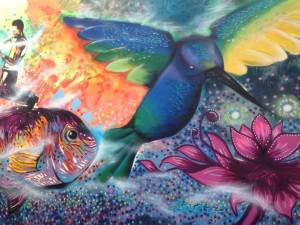
After our mural tour, I bought some shoes:
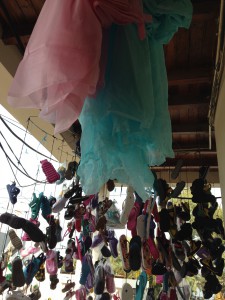
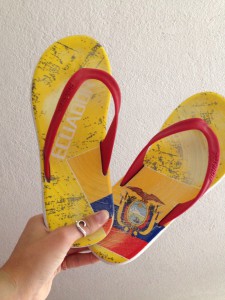
We then went to the beach, equipped with my waterproof kindle case that I used for an iphone to take a multitude of silly ocean related pictures.
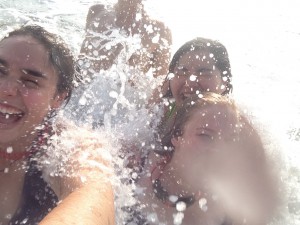
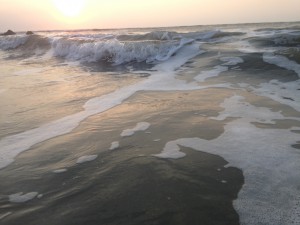
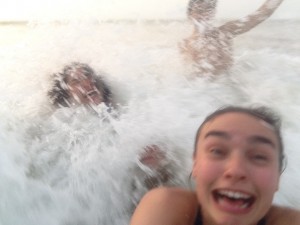
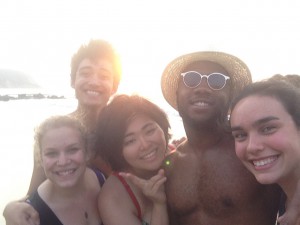

Wednesday we taxie-d over to the nature preserve, "Isla de la corazon" which is an area that has been restored to its original mangroves, after being destroyed to make room fro shrimp farmers years ago. We toured around in a motor boat, hearing about the astounding air purifying properties of mangroves, and their importance as a habitat for crabs (and therefore an important source of sustenance for crab fisherman) and a multitude of coastal birds as well. We rode in canoes through a channel in the center of the island as well, to get a closer look.
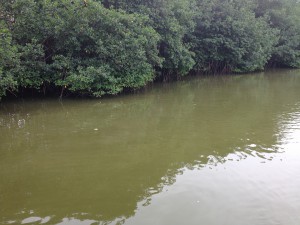
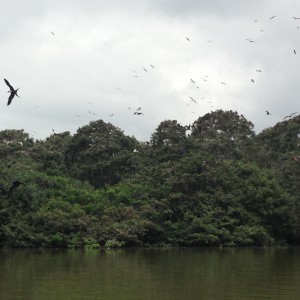
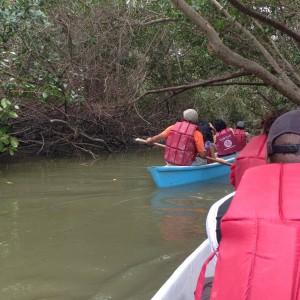
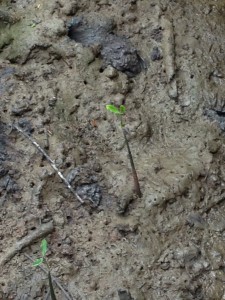

After returning from the island, we got some lunch at a fancy seafood place (ok, they are all pretty much seafood places, but Javier was in raptures about this one's food) we then went to another beach a taxi and also in this thing
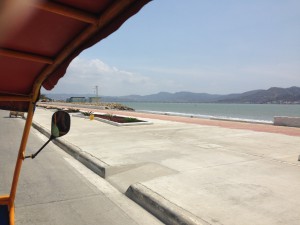
The beach is called Canoa, and there we took some more silly beach pictures, and ate pan de Yuca (more on that later)
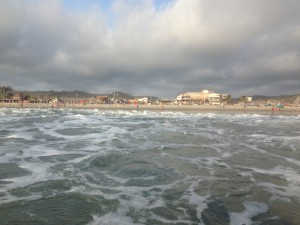
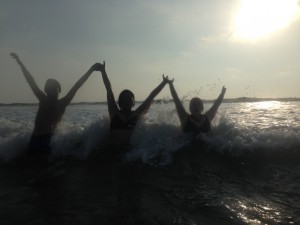
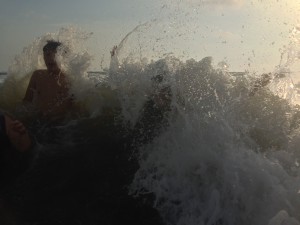
Thursday morning, we cooked with Lolita. Lolita is a 70 something lifelong Bahía resident and professional cook (as in people hire her to bake cookies for their weddings/various other events, and she sells her wears in the markets I believe) she also seems to serve as the neighborhood grandmother, from what I observed. The most impressive thing might have been seeing her open a can with a huge knife-calmly placing the tip at the edge of the can, then, lifting both and slamming them onto the counter together, fully opening a can neatly in three whacks-no can opener needed. Although the coconut cutting was impressive too.
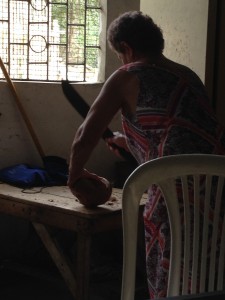
We also had an interesting discussion about butter-she uses margarine instead, because apparently the butter you can buy in the market nowadays is mixed with milk, ruining the consistency of the cookies-she knows her stuff.
We had a busy morning, makingfour recipes. The first was Galletas de Harina: tiny almost animal-cracker like cookies, that we all pitched in on forming, I was proud when she approved of my shapes, and threw Sixtina's back in to try again. We made Cocada, which is freshly machete-d and grated coconut cooked to a sticky paste with sweetened condensed milk and rolled into balls. Huevo Millo are made of a thick custard-like substance of eggs, and more sweetened condensed milk with a splash of liquor (we used a local variety made from sugar cane) and these are also rolled into little balls, but these get to be more fancy, receiving in addition some powdered sugar and fancy tissue paper wrappings.
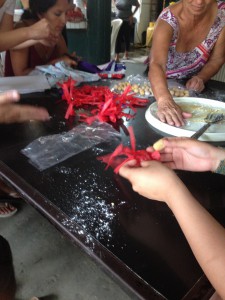
To take a little break from all the sweetness, we also made Pan de Yuca, which are little buns made half of a special kind of cheese that is specific to Manbí apparently, such that even in Quito it is hard to find. The other half is yuca flour, eggs and butter-so its no wonder these things are so delicious.
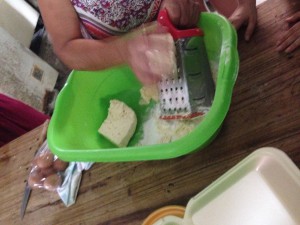
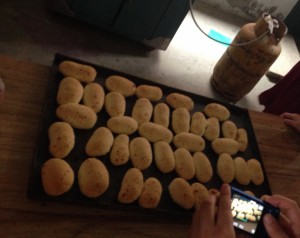
After our culinary adventure, we had class, then James, Tyler, Sarah and I walked down the coast to an apparently even grander beach than the one that was our neighbor across the street, but that was in fact decidedly underwhelming. Thus, after less than 20 minutes of swimming, we returned and showered in time to get dinner. Since it was Javier's birthday, Pilar and Rodolfo ordered a cake, and the evening was spend with drinks and cake on the terrace, with our group, plus the hotel owners, Sebastian, and Heysol herself (his wife) as well as the highly conservative retired couple vacationing from Detroit-quite a group. Despite Sarah's best efforts to explore the dancing scene that night, the busy day and cake meant that all the youngins soon drifted off to sleep, except Minori and I who stayed up far too late, having our own discussion, laughing and sharing stories into the night.
Friday we woke up later than had been originally planned (a change that had been agreed upon when Rodolfo and Pilar conferred sometime after midnight when the party broke up) and made our way to Porto Viejo where there was a lovely river to swim in to give us a break from the saltwater on that hot day (a change from the clouds that had characterized most of the week). I had empanadas de verde (as in the dough was made with green -read: unripe- plantains) stuffed with cheese, for lunch, which was delicious, and locally made coconut ice cream to finish off the meal.
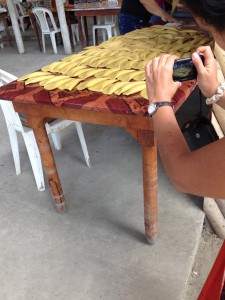
Next we piled back into the back of the pickup truck (much to our delight) and traveled to a nearby town whose name I have forgotten, where we each bought a large bag stuffed with all the kinds of cookies and sweets we had made the day before, plus still others. Entirely too much sugar-but quite yummy. We then proceeded to another village whose name I have forgotten already as well, where their main industry is carving jewelry and figurines out of a hard seed called Tagua (which apparently translates to "ivory palm" in English). There we explored and bought some things, like good little tourists.
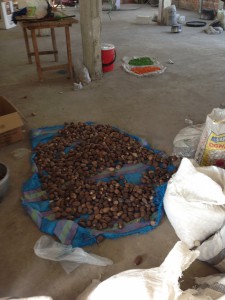
We then waited in the hot sun for far longer than seemed reasonable for a bus (so there is the suffering and authentic-ness that made us viajeros instead of turistas after all, right?) We finally took one that actually took us to Tosagua instead of Bahía, hoping we would be able to have better luck getting back to home base from there. After drinking a Borojó flavored batido (I still can't really tell you much about this fruit that I had never heard of either, but it was tasty) we did eventually get on a bus bound for the actual city we wanted to arrive in. It was quite late by the time we got back, so after relaxing a for a few hours, we had a light dinner and went to the club.
When we finally found it (asking someone got us close enough to follow our ears to the pulsing reggaeton beat) we found it ironic that it was named "Maui" even though it was on its own beach, yet was nevertheless named after an island city miles away…It was a lovely location though-with a deck protruding out over the waves, lights and "espuma" (foamy soap that was spread all over the floor every few minutes from a machine—is that a thing in the US too??) We had a nice time dancing for a few hours-enjoying the music and the view, and being goofy and all together. Tyler Minori and I left a bit earlier than the others, Tyler feeling the need to take the pineapple that was displayed near the bar, naming it Natasha as he snuck out with it-later gifting it to Sebastian and Heysol the next day, like some kind of pineapple Robin Hood…
Saturday morning we slept in gloriously late. Having forgotten to hang up our swim suits to dry from the river the day before, when I woke up, I went and put them on the terrace, so the sun could do its work. When we were ready to leave, I went up to collect mine, only to see that the bottoms had fallen off the railing onto the roof of the garage below. After determining that climbing down or up onto the roof was not really a safe option…

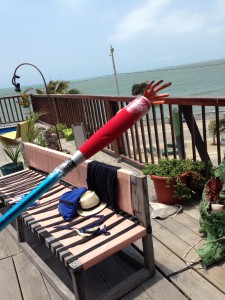
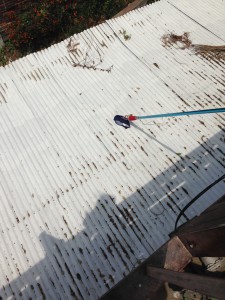
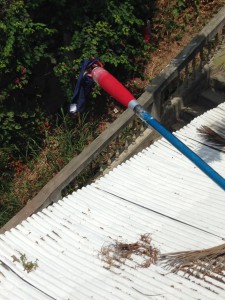

After this adventure, we got some lunch, (while discussing Pilar's research in food gentrification) then headed to Canoa beach once again. It was a lovely relaxing afternoon.
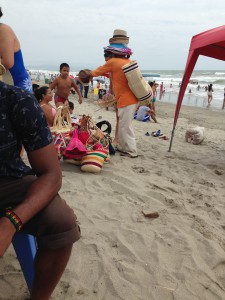
We returned (me wearing a newly bought dress) by bus, during which Sarah and I had a lovely discussion about world travel and death, concluding that this had been a great week for profound discussions. When we arrived back in Bahía we went straight to a restaurant for some dinner.
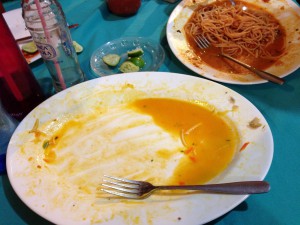
Sunday morning Sarah and I rose early for a leisurely jog on the beach (and I improvised a bra and underwear bikini on the deserted beach for one last goodbye dip in the Pacific) We then showered, gathered our possessions, shaking some of the sand out of them, said farewell to our hosts, and sadly climbed into our bus for the long journey back to Quito.
Since it is Tuesday by now, this new week has its new stories, but I will wait to recount those till I have a week's worth collected.
